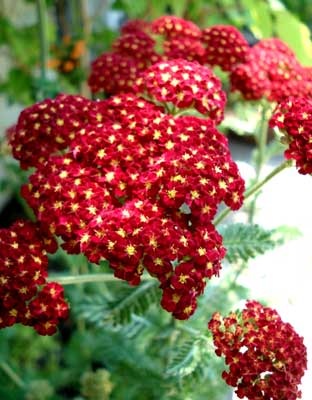
'Strawberry Seduction'
Red Yarrow
"She gathered herbs on the mountains & grasses on the rivers' banks; some she plucked up by the roots & some she cut with the curved blade of a knife. When she had gathered these herbs & grasses she went back to Corinth on her dragon-drawn car."
-Jason & Medea
by Padraic Colum
(1881-1972)
The deep carmine-red yarrow 'Strawberry Seduction' holds its color some while, but like 'Paprika' the yellow eye eventually expands until the flowers are a washed-out yellow, still somewhat nice looking. It has in its breeding heritage the red yarrow of southern Appalachia, Achillia millefollium var rubra, as do most reds, though 'Paprika' happens to get its red from A. m. var californica.by Padraic Colum
(1881-1972)
When the yellowed blooms are going to seed, they can be trimmed back to near the silver-green basal leaves. This will induce a fresh growth of ferny leaves out of which erupt a second round flowers. By such deadheading the clump can be kept blooming from July to October, or until first hard frost.
If its first flush of bloom is permitted to go to seed, however, the blooms last five weeks, & it quits, though cutting it back belatedly will still induce fresh basal foliage that can last through much of winter with a look similar to asparagus fern but for the sun-garden.
The "Seduction series" mostly duplicate existing color forms. Besides 'Paprika' there are similar varieties such as 'Red Velvet,''Cherry Queen,' 'Pomegranate,' 'Fanal' aka 'The Beacon,' 'Heidi,' 'Cerise Queen' & so on. If some of these shared the same sun-garden, chances are, as labels are in time faded or lost, it really won't be possible to figure out which one is 'Strawberry Seduction.'
To some extent "new" series & patented cultivars of achilleas (or many another standard perennial) really exist for the sake of continuous patenting, trademarking, & proliferation of licensing to growers of patented plants alleged to be "new." Advertisements thus set out to convince all of us willingly duped rubes that we're buying something new & improved, which is occasionally true, but all new introductions make the claims whether or not factual.
Developed in Lancaster, Pennsylvania, around 2002, from seedlings selected from the Summer Pastels series, the evident intent was to achieve stronger predictability of color since the 'Summer Pastels' were not entirely stable. The result is not necessarily an improvement over most extant cultivars, & certainly not a new color. Nor is this one more apt to grow true from seed, though it is easily started in coldframes from basal cuttings, & by autumn or spring division.
When released in 2008 it was advertised as having the distinct trait of a more compact habit. Well, maybe; it does in the main remain in the two-foot range, with sturdy enough stems that it is not as apt to lodge or lean over as do taller achilleas. It it seems to have stronger better-branching stems than 'Paprika,' though that doesn't mean its better than every red cultivar that has already come down the pike.
It's a nice perennial in any case, & worthy of any garden, though if you have other red varieties don't expect it seriously to be noticeably different from what you have already planted.
Care is as for other yarrows. It wants full sun in dryish to well-draining moist soil, but not too awfully droughty. Poor/light soil is preferred to loamy/rich, & it may lodge in overly fertile soils, though it's not otherwise fussy. It is good for the cutting garden, the butterfly garden, the xeric garden, containers, deer-resistant garden, or for use in dried flower arrangement. Foliage has marginal comestible value as peppery herb or in tea mixes, though overuse can be mildly toxic.
Continue to:
'Angel's Breath' Double Yarrow